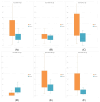Analysis of miRNA Expression Profiles in Traumatic Brain Injury (TBI) and Their Correlation with Survival and Severity of Injury
- PMID: 39273487
- PMCID: PMC11394952
- DOI: 10.3390/ijms25179539
Analysis of miRNA Expression Profiles in Traumatic Brain Injury (TBI) and Their Correlation with Survival and Severity of Injury
Abstract
Traumatic brain injury (TBI) is the leading cause of traumatic death worldwide and is a public health problem associated with high mortality and morbidity rates, with a significant socioeconomic burden. The diagnosis of brain injury may be difficult in some cases or may leave diagnostic doubts, especially in mild trauma with insignificant pathological brain changes or in cases where instrumental tests are negative. Therefore, in recent years, an important area of research has been directed towards the study of new biomarkers, such as micro-RNAs (miRNAs), which can assist clinicians in the diagnosis, staging, and prognostic evaluation of TBI, as well as forensic pathologists in the assessment of TBI and in the estimation of additional relevant data, such as survival time. The aim of this study is to investigate the expression profiles (down- and upregulation) of a panel of miRNAs in subjects deceased with TBI in order to assess, verify, and define the role played by non-coding RNA molecules in the different pathophysiological mechanisms of brain damage. This study also aims to correlate the detected expression profiles with survival time, defined as the time elapsed between the traumatic event and death, and with the severity of the trauma. This study was conducted on 40 cases of subjects deceased with TBI (study group) and 10 cases of subjects deceased suddenly from non-traumatic causes (control group). The study group was stratified according to the survival time and the severity of the trauma. The selection of miRNAs to be examined was based on a thorough literature review. Analyses were performed on formalin-fixed, paraffin-embedded (FFPE) brain tissue samples, with a first step of total RNA extraction and a second step of quantification of the selected miRNAs of interest. This study showed higher expression levels in cases compared to controls for miR-16, miR-21, miR-130a, and miR-155. In contrast, lower expression levels were found in cases compared to controls for miR-23a-3p. There were no statistically significant differences in the expression levels between cases and controls for miR-19a. In cases with short survival, the expression levels of miR-16-5p and miR-21-5p were significantly higher. In cases with long survival, miR-21-5p was significantly lower. The expression levels of miR-130a were significantly higher in TBI cases with short and middle survival. In relation to TBI severity, miR-16-5p and miR-21-5p expression levels were significantly higher in the critical-fatal TBI subgroup. Conclusions: This study provides evidence for the potential of the investigated miRNAs as predictive biomarkers to discriminate between TBI cases and controls. These miRNAs could improve the postmortem diagnosis of TBI and also offer the possibility to define the survival time and the severity of the trauma. The analysis of miRNAs could become a key tool in forensic investigations, providing more precise and detailed information on the nature and extent of TBI and helping to define the circumstances of death.
Keywords: miR-130a; miR-155; miR-16; miR-21; miR-23a; miRNA; molecular diagnostics; molecular pathology; molecular pathology of traumatic injuries; traumatic brain injury.
Conflict of interest statement
The authors declare no conflicts of interest.
Figures





Similar articles
-
miR-142-3p Expression Is Predictive for Severe Traumatic Brain Injury (TBI) in Trauma Patients.Int J Mol Sci. 2020 Jul 29;21(15):5381. doi: 10.3390/ijms21155381. Int J Mol Sci. 2020. PMID: 32751105 Free PMC article.
-
Screening the expression of several miRNAs from TaqMan Low Density Array in traumatic brain injury: miR-219a-5p regulates neuronal apoptosis by modulating CCNA2 and CACUL1.J Neurochem. 2019 Jul;150(2):202-217. doi: 10.1111/jnc.14717. Epub 2019 Jun 25. J Neurochem. 2019. PMID: 31077370
-
Expression profile of plasma microRNAs and their roles in diagnosis of mild to severe traumatic brain injury.PLoS One. 2018 Sep 18;13(9):e0204051. doi: 10.1371/journal.pone.0204051. eCollection 2018. PLoS One. 2018. PMID: 30226895 Free PMC article.
-
An Overview on the Use of miRNAs as Possible Forensic Biomarkers for the Diagnosis of Traumatic Brain Injury.Int J Mol Sci. 2023 Mar 30;24(7):6503. doi: 10.3390/ijms24076503. Int J Mol Sci. 2023. PMID: 37047473 Free PMC article. Review.
-
MicroRNAs as potential biomarkers for the diagnosis of Traumatic Brain Injury: A systematic review and meta-analysis.Int J Med Sci. 2021 Jan 1;18(1):128-136. doi: 10.7150/ijms.48214. eCollection 2021. Int J Med Sci. 2021. PMID: 33390781 Free PMC article.
Cited by
-
Therapeutic potential of exosomal lncRNAs derived from stem cells in wound healing: focusing on mesenchymal stem cells.Stem Cell Res Ther. 2025 Feb 11;16(1):62. doi: 10.1186/s13287-025-04200-0. Stem Cell Res Ther. 2025. PMID: 39934913 Free PMC article. Review.
-
Potential Correlation Between Molecular Biomarkers and Oxidative Stress in Traumatic Brain Injury.Int J Mol Sci. 2025 Apr 18;26(8):3858. doi: 10.3390/ijms26083858. Int J Mol Sci. 2025. PMID: 40332547 Free PMC article. Review.
-
Extracellular vesicles as biomarkers for traumatic brain injury using a 3D in vitro human brain tissue model.Sci Rep. 2025 Jul 24;15(1):26940. doi: 10.1038/s41598-025-04835-2. Sci Rep. 2025. PMID: 40707605 Free PMC article.
References
-
- GBD 2016 Traumatic Brain Injury and Spinal Cord Injury Collaborators Global, regional, and national burden of traumatic brain injury and spinal cord injury, 1990–2016: A systematic analysis for the Global Burden of Disease Study 2016. Lancet Neurol. 2019;18:56–87. doi: 10.1016/S1474-4422(18)30415-0. - DOI - PMC - PubMed
MeSH terms
Substances
LinkOut - more resources
Full Text Sources
Medical

